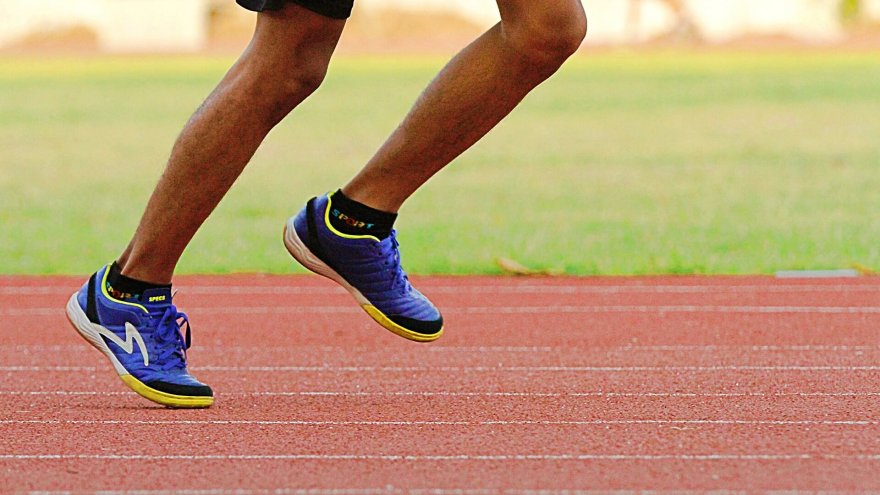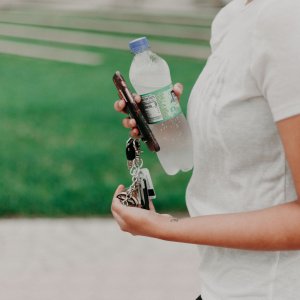Taking It In Stride: Things That Can Throw Yours Off

Of course, an injury like Achilles tendinitis or plantar fasciitis is going to throw off your stride, if you can even run at all.
But even a minor injury like a blister or a scraped knee can cause you to limp a little and that could be just enough to throw a wrench in an otherwise smooth, efficient gait.
Limping a little bit for a short period of time—say the time it takes to heal a blister—is probably no big deal but if you limp for longer periods—say trying to power through that severe case of plantar fasciitis—it can cause injury to your uninjured leg/foot as well as back, shoulder and neck problems.
But there are other more subtle things that you may do on every run that could be playing havoc with your stride. And that over time may cause muscle imbalances as well as chronic injuries. Not to worry though, each issue has a relatively easy fix.

Photo from Pixabay
Running around…and around…and around a track
Obviously, if you are on a track team, there is no way to avoid running on a track, at least for meets and certain track workouts.
But if you routinely log your miles on a track, no matter what the surface and either indoor or outdoor, muscle imbalances are inevitably going to occur. These imbalances can easily result in injury.
Smaller tracks—usually indoor ones that tend to be 150 to 200 meters—exacerbate the issue as there is sometimes more turn than there is straightaway.
A study published in the October 2000 issue of the Clinical Journal of Sports Medicine seems to bear that out.
During the study, which is titled “Asymmetrical strength changes and injuries in athletes training on a small radius curve indoor track,” researchers measured the peak torque of certain muscle groups in 25 track athletes both before the season started and after the season ended.
They found that on the inside (left) leg, a certain set of foot muscles—invertors—increased in strength significantly more than that same set of muscles on the foot of the outside (right) leg. And they found the opposite was true as well—that on the outside leg, a second set of foot muscles—the evertors—were markedly stronger than the evertors on the foot of the inside leg.
They also noted a high injury rate to a lower extremity—68%—among the 25 participants, who competed in events from the 200 to 3,000 meters.
The easy fix for this is to alternate the direction you run on a track…equally, if you can. So, if you typically run 3 miles on the track, run one and a half miles counterclockwise and the other mile and a half clockwise.
Or split it up however it is easiest for you to keep track, by time or distance. Be mindful of your fellow athletes (who may still be running in one direction) and yield to those who might be doing a track workout in lane 1.

Photo from Pixabay
On the road again
After I suffered a severe iliotibial band strain, my orthopedist advised me that when I did return to running, I try to run on sidewalks instead of roads, as much as possible, at least at first.
The reason, he explained, is that roads are generally domed—or cambered—to facilitate water run-off. So the highest point on a road is the center line and the road curves downward to each side.
So, if you are following the rules of the road and always run facing traffic, which is the safest option, the same leg will be lower for the duration of your run.
If you run primarily on the roads, over time and distance, this can increase your chance for injury.
Although there hasn’t been much research on the effect of running on cambered surfaces, one study did measure lower extremity muscle activity of runners both on flat and sloped surfaces.
Researchers of the study—“What is the influence of cambered running surface on lower extremity muscle activity?”—found that running on a sloped surface changes the muscle activity in the leg on the curbside of the road, most likely from compensating for the differences in surface height.
The study was published in the August 2013 issue of the Journal of Applied Biomechanics.
The way around the camber issue is to vary the surfaces on which you run from time to time. If you can, opt for a trail, grass, track or the sidewalk a couple of times a week instead of the road. If you are limited to the road, however, switch up your routes so that you aren’t running with the same leg always on the curbside. This may necessitate running with traffic instead of against it, so be extra cautious in this situation.

Photo by i love simple beyond from Pexels
Having your hands full
Do you carry a water bottle, keys or your cell phone in your hand during a run? If so, you may be throwing off your stride at least a little bit, which on shorter, less frequent runs may not be a big deal. If it is something you do all the time or on longer runs however, the impact to your stride could add up.
Arm swing and a stable upper body are integral to a smooth, efficient stride. Your trunk should have little rotation and your arms should swing an equal amount.
Carrying something as light as a cell phone can impact the amount that arm swings and in so doing, can throw off your stride since your arms and legs move proportionately. Carrying something heavier like a full water bottle can heighten the impact.
Although researchers found no significant difference in running kinematics of those who carried nothing, carried a half-full water bottle, a full water bottle, or a bottle belt holder, they did hypothesize that it is likely that the runners made adjustments to compensate for what they were carrying.
The study, “Running Mechanics and Metabolic Responses With Water Bottle and Bottle Belt Holders,” only measured the runners over short distances. Carrying something during a long-distance run or for frequent runs wasn’t studied. The study results were published in the September 2018 issue of the International Journal of Sports Physiology and Performance.
There are a number of ways to carry something on a run that won’t impact the efficiency of your stride. An armband for your phone, a waist belt for your phone and/or keys, a bottle belt or hydration pack for your water are all good options.
If you must carry something on your run, try to swing your arms as equally as possible and switch off hands at regular intervals. Pick a time interval or a distance after which you move what you are carrying from one hand to the other and then keep switching off for the rest of the run.
Sometimes I even switch my armband from one arm to the other. At my age, I need all the efficiency I can get.
Sources
- , Asymmetrical strength changes and injuries in athletes training on a small radius curve indoor track., Online journale
- , Injuries induced by running the same direction on an indoor/outdoor track., Website
- , What is the influence of cambered running surface on lower extremity muscle activity?, Online journal
- , Running Mechanics and Metabolic Responses With Water Bottles and Bottle Belt Holders., Online journal
- , Running Technique: How Your Phone Or Water Bottle Can Hurt Your Run, Online video
Latest Articles
 Is Running on a Treadmill Easier Than Running Outside?Runners have their own preferences, whether it is treadmill running, running outside on the road, or exploring trails. So...
Is Running on a Treadmill Easier Than Running Outside?Runners have their own preferences, whether it is treadmill running, running outside on the road, or exploring trails. So... Is It OK to Use Trail Running Shoes on the Road?While trail running shoes can be used on roads, especially in situations where a runner encounters mixed terrains or pref...
Is It OK to Use Trail Running Shoes on the Road?While trail running shoes can be used on roads, especially in situations where a runner encounters mixed terrains or pref... How to Fix Sore Quads After Running?Rest, ice, gentle stretching, and over-the-counter pain relievers can help soothe sore quads after running. Also, ensure ...
How to Fix Sore Quads After Running?Rest, ice, gentle stretching, and over-the-counter pain relievers can help soothe sore quads after running. Also, ensure ... 10 Fruits With The Most Electrolytes to Replace Sports DrinksThese fruits are high in electrolytes such as potassium, magnesium, and calcium, essential for hydration, muscle function...
10 Fruits With The Most Electrolytes to Replace Sports DrinksThese fruits are high in electrolytes such as potassium, magnesium, and calcium, essential for hydration, muscle function...

